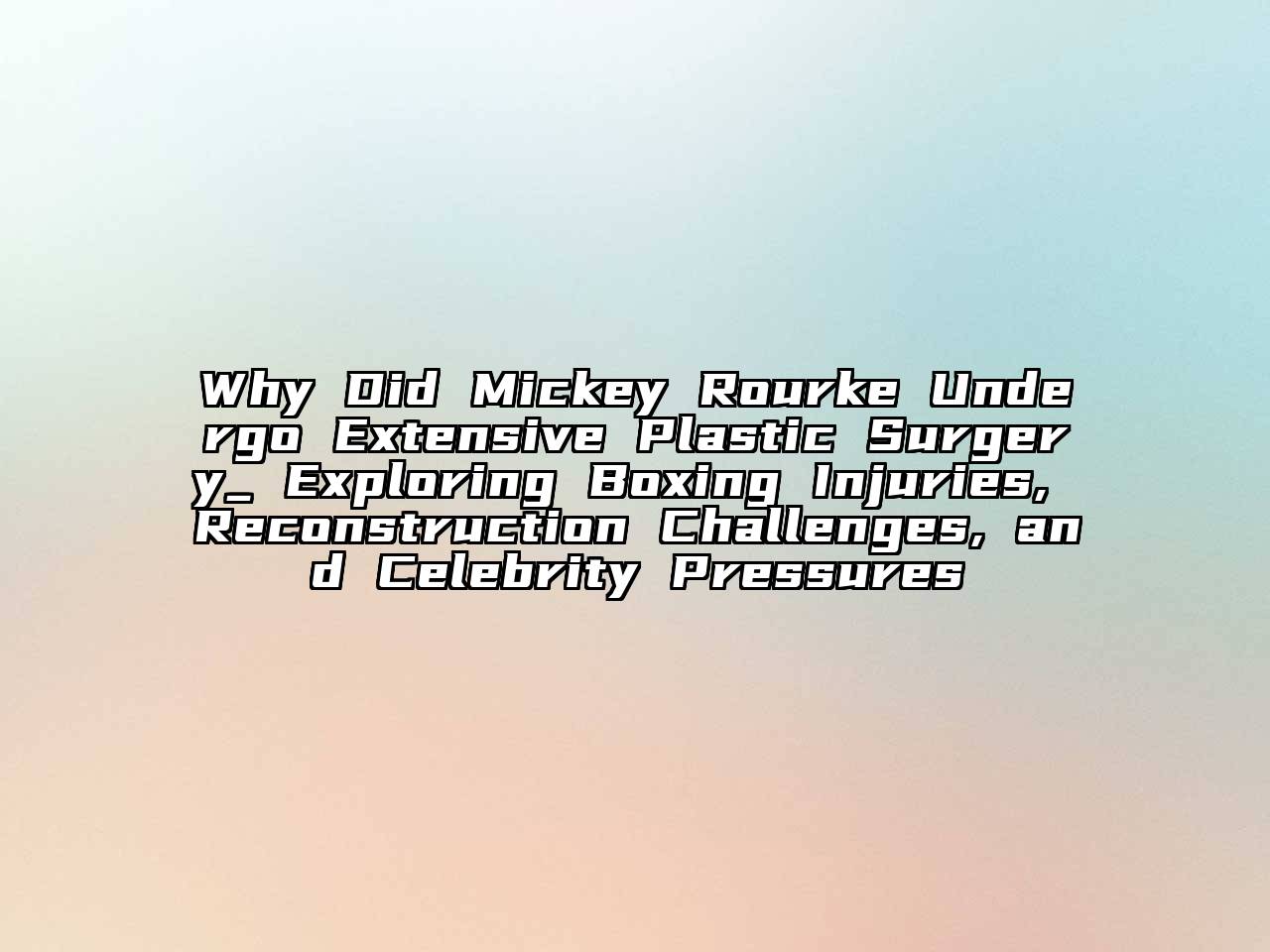Why Did Mickey Rourke Undergo Extensive Plastic Surgery_ Exploring Boxing Injuries, Reconstruction Challenges, and Celebrity Pressures
The haunting transformation of Mickey Rourke—once a heartthrob in 9½ Weeks, later unrecognizable after multiple surgeries—ignites uncomfortable questions about celebrity culture, trauma recovery, and the thin line between reconstruction and dysmorphia. Beyond tabloid fascination, Rourke’s journey reveals universal truths about how physical trauma, psychological pressures, and surgical limitations converge. This investigation unpacks the multidimensional forces behind his choices while offering cautionary insights for those considering cosmetic interventions.
🥊 The Unseen Battle: Boxing Trauma as Catalyst
Rourke’s boxing career (1991–1994) inflicted devastating facial damage:

Nasal Fractures: 5+ breaks requiring repeated rhinoplasties that collapsed due to cartilage loss.
Orbital Trauma: Shattered cheekbones necessitating titanium implants, later causing chronic nerve pain.
Scar Tissue Buildup: Multiple revisions led to fibrosis—thickened, rigid skin that limited expression and distorted features.
💔 Rourke’s admission: "I had my nose broken twice. My cheekbone, jaw, ribs, and toe... I had surgery to scrape the cartilage in my nose. It didn’t work"—highlighting how athletic trauma created a surgical domino effect.
🧠 Psychological Perfect Storm: Fame, Trauma, and Identity Loss
Three intertwined factors fueled Rourke’s surgical spiral:
Career Collapse: After Wild Orchidflopped, Rourke linked his looks to professional rejection—"I became the monster nobody wanted".
Body Dysmorphia: Fixation on perceived flaws despite objective disfigurement.
Surgical Addiction: Chasing "repair" through repeated interventions despite diminishing returns.
⚠️ Critical Insight: Rourke’s case exemplifies surgical snowballing—where initial functional repairs trigger aesthetic obsessions.
🏥 Surgical Reality Check: When Reconstruction Fails
Rourke’s outcomes reveal hard truths about limitations:
Procedure | Intended Goal | Actual Outcome | Medical Reason |
|---|---|---|---|
Rhinoplasty | Restore nasal function | Collapsed bridge | Insufficient septal cartilage |
Cheek Implants | Rebuild bone structure | "Pillow face" appearance | Scar tissue encapsulation |
Brow Lifts | Reduce scarring | Frozen expression | Nerve damage from repeated trauma |
📌 Prevention Tactics:
Single-Stage Reconstruction: Combining bone grafts + soft tissue repair in one surgery reduces fibrosis risk.
3D-Printed Implants: Custom-designed materials now prevent implant shifting.
Therapy Mandates: Top clinics require psychological screening before revision surgeries.
🌟 Celebrity Pressures: The "Monster" Paradox
Hollywood’s beauty standards amplified Rourke’s struggles:
Typecasting Trap: Post-boxing, he was offered only "thug" roles, reinforcing his belief that his face was "damaged goods."
Public Humiliation: Talk show hosts like David Letterman mocked his appearance, deepening shame.
Industry Rejection: Directors openly stated he was "uninsurable"due to surgery risks.
🎭 The Irony: Rourke pursued surgery to regain his career—yet the results ended it for a decade until The Wrestler’s comeback.
🛑 Avoiding the "Rourke Effect": Lessons for Patients
Rourke’s experience offers vital safeguards:
Trauma-Informed Surgeons: Seek specialists in facial trauma reconstruction (not just cosmetics) for complex cases.
Realistic Timelines: Accept that scar tissue maturation takes 12–18 months before considering revisions.
Psychological Vetting: Clinics like the Cleveland Clinicnow require BDD screenings before multiple procedures.
Non-Surgical Alternatives: Modern fillers (e.g., Radiesse) can camouflage bone loss without surgery.
❓ FAQ: Navigating Surgical Realities
Q: "Can boxing injuries be repaired without distortion?"
A: Yes—with advanced techniques:
Custom Implants: 3D-printed porous polyethylene mimics bone structure.
Fat Grafting: Repurposes body fat to fill scarred areas naturally.
Early Intervention: Addressing fractures within 48 hours prevents malunion.
Q: "How many surgeries are too many?"
A: No universal number—but warning signs include:
Surgeon shopping after 2+ revisions
Ignoring medical advice against further procedures
Obsessively focusing on minor flaws
Q: "Did Rourke’s surgeries cause chronic pain?"
A: Likely yes. Nerve entrapment from scar tissue causes trigeminal neuralgia—a condition Rourke referenced when describing "constant burning"in his face.
💎 The Unspoken Truth: Redemption Beyond the Mirror
Rourke’s legacy isn’t surgical failure—it’s resilience. His Oscar-nominated return in The Wrestlerproved talent transcends appearance. Yet his journey remains a stark reminder: surgery can rebuild bones, but only self-acceptance rebuilds identities. For those considering cosmetic interventions, let Rourke’s experience affirm that true transformation begins when we stop fighting our reflections.
Related articles
- What are the top considerations and expert tips when choosing the Atlanta Center for Plastic Surgery for your cosmetic needs_
- Considering Non-Surgical Options_ Explore Asia Cosmetic Hospital Thailand_ The Best in Plastic Surgery and MedSpa Treatments
- What Are Real Patient Experiences with Brzowski Eye Lift Procedure Recovery Timelines and How to Prepare for Optimal Results_
- How to Achieve Natural Looking Results from Plastic Surgery Institute Beverly Hills_ Exploring Celebrity Techniques and Personalized Facial Rejuvenation Strategies
- What Are the Best Bespoke Plastic Surgery Options in Charlotte NC for Natural-Looking Results_ Discover Expert Insights & Personalized Care Approaches
- Dr Danyo Plastic Surgery Techniques_ How Patients Achieve Natural-Looking Results Through Personalized Surgical Plans and Advanced Methods
- What Procedures Do Love Island Stars Reverse After the Show and How Can Viewers Avoid Cosmetic Regret_
- What Are the Most Effective Minimally Invasive and Surgical Facial Rejuvenation Options Offered by Dr. David Stoker_ Comparing Techniques, Results, and Recovery
- Can I Write Off Plastic Surgery on My Taxes_ When Procedures Qualify as Deductible Medical Expenses and How to Claim Them Legally
- What Are the Most Frequently Asked Questions About Dr. Adamson’s Plastic Surgery Services in Sarasota_
- Why Did Mickey Rourke Undergo Extensive Plastic Surgery_ Exploring Boxing Injuries, Reconstruction Challenges, and Celebrity Pressures
- What Are the Risks, Benefits, and Realistic Outcomes of BRE Tiesi’s Plastic Surgery_
- What Do Patients Say_ Evaluating The Julian Institute of Plastic Surgery Reviews and How They Guide Your Decision
- Why Do People Speculate About Cillian Murphy’s Plastic Surgery_ Exploring The Truth Behind The Actor’s Changing Looks
- What Costs to Expect and How to Plan Your Recovery Timeline for a Tummy Tuck at Gemini Plastic Surgery
- How Can Aspiring Plastic Surgery Nurses Effectively Prepare for Certification, Clinical Training, and Career Placement_
